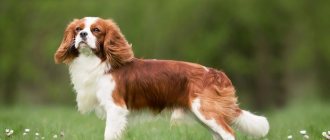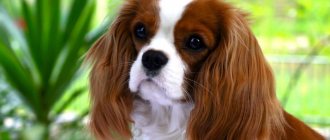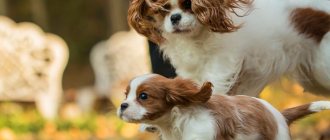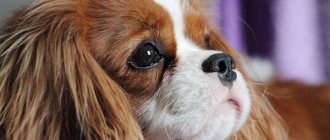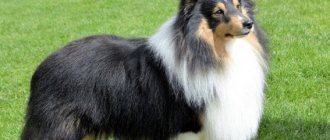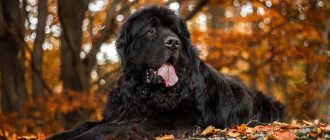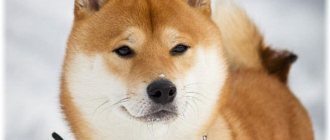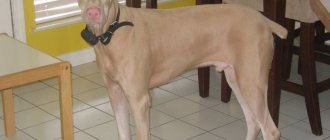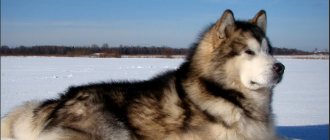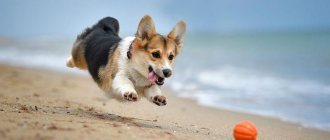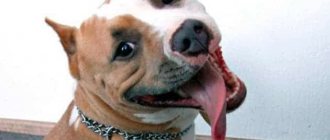- Pets
- >>
- Dog breeds
* Here is a photo of a typical representative of the Cavalier King Charles Spaniel dog breed . You can send us photos of your animals by email, and we will post them on the website. Don't forget to send your pet's name.
Video
* We invite you to watch a video about the Cavalier King Charles Spaniel . In fact, in front of you is a playlist in which you can select and watch any of 20 videos about a given dog breed by simply clicking on the button in the upper right corner of the window. In addition, the material contains quite a lot of photos. By looking at them you can find out what a Cavalier King Charles Spaniel looks like.
In this article:
|
How to choose a puppy
When choosing a Cavalier King Charles Spaniel puppy, you can follow the same principles as when buying any other purebred dog.
- Do not take babies from nurseries that are unsanitary and disorderly.
- To insure yourself against purchasing a sick animal, ask the breeder for the results of tests aimed at identifying genetic diseases in the puppy (dry eye syndrome, curly hair, occasional falls).
- The temperament of Cavalier King Charles Spaniels is not gender dependent. Both females and males of this breed are equally affectionate and affectionate to their owner, so choose an animal according to your own preferences.
- Get to know the puppy's parents and their pedigree to avoid purchasing an inbreeding animal (from closely related individuals).
- Choose a playful, inquisitive baby who shows a keen interest in toys. Lethargy and hesitation in Cavalier King Charles Spaniel puppies indicate that they are physically and mentally exhausted.
History of the Origin of Cavalier King Charles Spaniels
The Cavalier King Charles belongs to the group of small (toy) spaniels, whose ancestors were most likely Asian breeds of small dogs such as Tibetan spaniels or Japanese chins. Such dogs can often be seen in European paintings starting from the 15th century. They are photographed in luxurious palace interiors, posing with royal families and accompanying noblemen on walks.
Small spaniels were especially popular during the reign of Kings Charles the First and Second, in the early to mid-17th century. In honor of the kings, the dogs began to be called King Charles Spaniels (Charles in English spelling - Charles). More than a hundred dogs of this breed were kept at the royal court alone, each of which was served by its own groomer.
But fashion changed with the change of dynasties and by the end of the century everyone fell in love with pugs, imitating William of Orange, who took the royal throne. Spaniels began to change their appearance, acquiring the features of new favorites: a flat muzzle, a rounded skull, low-set ears. This type began to predominate towards the end of the 19th century.
Dog handler Roswell Eldridge from the USA decided to revive the old type that charmed him in ancient portraits. Since 1926, he began collecting old-fashioned puppies for his kennel, which from time to time were born to new types of dogs. These pups and Eldridge's followers created a new breed. She became known as the Cavalier King Charles Spaniel. The short-faced type retained the former name “King Charles Spaniels.”
The English Kennel Club registered the breed in 1928, establishing its standard, but it was not until 1945 that the short-faced and long-faced spaniel breeds were recognized as independent. In addition to the long muzzle, Cavaliers are distinguished by a flat skull, high-set ears and larger size. The international federation FCI recognized her in 1955, placing her in the section of English Toy Spaniels from the group of decorative dogs and companions.
How does pricing work?
There are few factors that influence the cost of a puppy (or the entire litter). A few days later (or before sale), the dog breeder evaluates the entire litter. All young animals undergo strict control and are distributed into the following groups:
Show class
All the most promising puppies that can build an excellent show career acquire “show class” status. They are closest to the breed standard, which means they are more likely to be highly rated by expert judges.
The price for promising puppies is very high and can even reach 100 thousand rubles, regardless of the breed.
Brid class
Most often, this group includes individuals that have minor deviations from the accepted exterior. They are allowed to participate in exhibitions and can even receive good marks. Breed bitches are used for targeted breeding. They are quite capable of producing show class offspring.
Pet class
All young animals are culled from the first days of life. The presence of disqualifying defects, the detection of genetic diseases or pronounced mutations deprive the puppy of a show career. He is purebred and may be branded, but is only suitable as a companion. The pet class has a low price, and the breeder tries to get rid of puppies with pronounced defects as quickly as possible. Such individuals can be bought literally “for pennies.”
The older the puppy gets, the lower the price. Breeders, as a rule, try to sell a young dog faster and may reduce its price.
However, during this time, the grown-up puppy develops its own character and habits, which may be undesirable to the potential owner.
After deciding which type of puppy you are most interested in, you can begin searching for offers in various online resources.
Cavalier King Charles Spaniel - description of the breed
An active, cheerful dog with an elegant, well-balanced, athletic exterior. Cheerful by nature, absolutely fearless, friendly, with no signs of aggression towards strangers. Not prone to hysterics. Height (at the withers) 30 – 33 cm with weight – 4.5 – 8 kg.
Construction details:
- The head has a flat (between the ears) skull, the stop is smoothed. The black nose ends with a wedge-shaped muzzle up to 4 cm long. The lips are not drooping, the jaws are strong and well closed. The bite is like a scissors, that is, the top row overlaps the bottom;
- The eyes are round and large, spaced apart, dark;
- The ears are hanging, long, with lush, beautifully hanging fur;
- The neck is of moderate length and slightly arched;
- The body has strong muscles, the back is straight, fairly wide, the lower back does not bend. The chest is not expanded, with springy ribs;
- The tail is raised, showing good humor, but not much higher than the level of the back. It can be stopped by no more than a third. It should be borne in mind that some systems prohibit docking for humanitarian reasons;
- Legs with moderately thick bones, strong, straight, with neat paws gathered into a ball. They move freely, gracefully, the back and front are parallel to each other;
- The coat is long and silky, straight or with a slight wave, flutters beautifully, without trimming.
Disadvantages of the breed are considered to be deviations from the listed parameters. The severity of the deficiency depends on the degree of deviation and, especially, on its effect on the health of the animal. Dogs with behavior unusual for this breed, aggressive or excessively fearful are subject to disqualification.
Description of the breed
The main characteristics of spaniels that are “created by a king”:
- the weight of the dog is determined by gender, females are noticeably lighter than males, and is 5-6 kg for girls and 8-10 for boys;
- The height of dogs also depends on gender, the difference is about 10 cm. The size of an adult dog: females grow up to 25 cm, males up to 35 cm at the withers;
- color . With the establishment of a new breed standard, color options took root: four types in total. The first is black combined with beautiful bright tan marks; the second is ruby, so named because in the sunlight this bright red color sparkles like a precious stone; the third is called “tricolor” because it combines black, red, and piebald colors; and, finally, the fourth type - Blenheim - bright red spots with clear outlines stand out on a white-pearl base;
- head _ The muzzle is wedge-shaped, the lips do not droop;
- bite ;
- eyes are round, protruding and shiny;
- ears with elongated hair;
- the body is small but muscular, with a flat back and prominent ribs;
- the tail is in constant motion and is proportional to the body. Sometimes it can be docked by one third of the total length;
- the coat is thick, shiny and very silky;
- life expectancy is from 10 to 15 years.
Photo: wikimedia.org
The difference between a Cavalier and King Charles
Let us note that these two breeds are very closely related historically and, until a certain point in their development, were considered one. In modern conditions, these are two different breeds that differ in a number of ways:
- Nose length. The cavaliers have longer ones, the kings have snub noses;
- Skull shape. For a cavalier it is almost flat, for a king it looks like a dome;
- Bite. The Cavalier has a scissor bite, the King has an undershot bite;
- Size difference. Kings are smaller than Cavaliers.
Photo: sidewaysdogs.com
Popular colors of Cavalier King Charles Spaniels
The colors of the cavalry outfits correspond to those that were seen in the times of the Stuarts and captured by the artists of that time. Eldridge, when collecting the founders of the breed, offered £25 for dogs similar to those in paintings contemporary with Charles II. Although the main attention was paid to spaniels of the Blenheim color - the most valuable and unique, characteristic of this breed.
Colors should be rich, rich, without halftones. Colored spots, including scorch marks, are evenly colored and sharply outlined (without merging, the so-called “raincoat”).
There are four types of colors in total:
- Blenheim is a special breed color: bright and clear chestnut spots are scattered on a snow-white background, two spots on the sides of the head are symmetrical, extending over the eyes, leaving a white muzzle, forehead and, often, a stripe on the head. It is desirable that this stripe (on the crown) have a chestnut spot in the shape of a diamond (Blenheim spot);
- Black and tan - the entire coat is black, the tan marks are bright red, on the usual places: eyebrows, cheeks, chest and paws, under the tail and on the inside of the ears. Preferably without white markings;
- Bright dark red (ruby, red) – the whole dog has an even fiery red color, preferably without white markings;
- Tricolor (three-color) - a fur coat with black and white spots that are clearly separated from each other without gray areas. There are tan marks on the cheeks, eyebrows, on the inside of the ears and legs, and also under the tail.
Any other colors or patterns or combinations of the listed colors are undesirable. In solid colors, a small white marking on the chest or throat is acceptable. But there should be no white spots on the paws, muzzle and forehead. In colors with white, speckling on white areas is not allowed.
Color can subconsciously influence the choice of a pet. For example, light and bright dogs seem more cheerful and kind. In fact, such a dependence does not exist, and when choosing a puppy, you need to focus on the behavior of the animal, and not its color.
Character and habits of Cavalier King Charles Spaniels
You don’t need any special knowledge to handle this breed of dog; it doesn’t have any specific needs. It is quite suitable for inexperienced owners who are just joining the ranks of dog owners. It is enough to master the general rules of relationships with dogs to get a Cavalier King.
Interesting fact: The main character traits of gentlemen are spelled out in the standard - friendliness and playfulness. Dogs are emotional to the point of incontinence, but show only positive emotions. Aggressiveness and fearful hysteria are not characteristic of them, at least not of purebred individuals. The manifestation of such qualities serves as a basis for disqualification and a ban on mating.
A decent gentleman not only adores his owner, he is equally friendly with all family members and loves to play with children. Even if they cause him inconvenience and pull his ears, the gentleman does not snap, but simply tries to avoid contact. But when alone, the pet truly suffers and its favorite place is always next to its owner.
Cavalier Kings treat strangers as potential friends and bark out of excitement, not anger. If they see a stranger as dangerous, they will most likely run away. The guards among them are useless. In their relationships with dogs, they do not try to dominate or defend territory, preferring to play.
On a five-point scale, a gentleman can be characterized as follows:
- 5 - attitude towards children, qualities of a companion;
- 4 - getting along with other pets, adaptability to city housing, ability to train, difficulty in caring for, suitability for agility;
- 3 - molting, watchdog qualities, need for physical activity;
- 1 - security qualities, ability to hunt.
Mass commercial breeding often neglects the careful selection of partners and the culling of puppies, so dogs appear on the market that lack the most valuable quality of the breed - its good nature. Some owners cultivate hostility in their pets towards everyone around them. Unable to bite, they realize their desire through the dog.
Features and description
The Cavalier King Charles Spaniel cannot be called homely She is bright, pretty and memorable. Most owners of such an animal literally dote on it. And this is not surprising. It has an attractive charisma. It is interesting that despite the dog being classified as a spaniel, it is completely devoid of hunting potential.
Aggression is not characteristic of him, as well as well-developed observation and a sense of suspicion. Also, the dog cannot boast of excellent adaptation skills. At first glance, it may seem that these are its shortcomings. In fact, dogs without developed working abilities are excellent companions.
Being close to the owner is the main desire of the Cavalier King. He quickly finds a common language with the person who adopted him, as he is characterized by contact and sociability. He happily gets along not only with the owner-leader, but also with other people. He is very happy when guests come to the house.
The dog's homeland is England. Several centuries ago, only aristocrats could afford to have one. Today the situation is the opposite. Yes, a representative of the breed can hardly be called a cheap pet, but it is accessible to everyone.
Breeders insist that he was bred by crossing Pugs with Spitz and Maltese dogs. It's hard to argue with this, because the standardized Charles King does have the genetic traits of all these dogs. He has established himself as a noble and respectable dog. The mistresses of such a favorite often invited artists to the house so that they could depict them on canvas.
The advantage of such a dog was that it always had a calm disposition and could easily sit on its owner’s legs for several hours. The artist did not have to be angry because the pose of the sitters often changed and he had the opportunity to complete the work on time.
The largest population of such dogs is in the USA. There they were especially loved by retired women. The modern representative of the breed is a frequent guest at exhibitions of decorative dogs, as well as at other events dedicated to animals.
Interesting facts about Cavalier King Charles Spaniels
Doggies, tiny little creatures that can be carried in your arms, have been valued by noble ladies since the Middle Ages. Ladies suffered from fleas without reliable insecticides. Fur trinkets, dogs and other furry animals with an obedient character served to attract insects. King Charles spaniels, the prototypes of the modern cavalier, fit this role perfectly both in size and character.
The Blenheim color is so named because the first Duke of Marlborough, John Churchill, kept spaniels of this color at his Blenheim estate in the 18th century. He went hunting with them to the park and appreciated the fact that they kept up with the horse. What their hunting success was is unknown; modern cavaliers are not very good as a hunter's assistant.
As for the notorious spot on the head, its origin is much more mysterious. The legend that tells of his appearance will satisfy only lovers of mysticism. It tells that while the Duke of Marlborough was at war, his wife was naturally agitated and, in order to calm down, kissed her pregnant dog on the crown. As a result, the dog gave birth to puppies with such spots.
There is also a popular legend that there is a special decree of Charles the Second allowing King Charles Spaniels to enter any institution in Great Britain. Previously, only guide dogs had this right. In one version of the myth, the permission applies only to the Houses of Parliament.
The UK Parliament website has had to deny that, contrary to popular rumours, Parliament's rules do not state that King Charles Spaniels are allowed into the Palace of Westminster. Despite searches, no trace of such a decree from the king has been found.
Pros and cons of Cavalier King Charles Spaniels
Quarry Kings are considered an easy breed that can be mastered by a novice dog breeder. The main thing is that they are not aggressive, and an error in handling them will not lead to serious injuries. However, a breed is a breed, but we must not forget about socialization and training. If you don’t work with your dog and let its upbringing take its course, it is unlikely to show its valuable qualities.
After proper socialization, gentlemen will get along without problems with a large family, with small, restless children. They will be able to get used to other pets, although their desire to play will not always be met with pleasure. And the remaining remnants of the hunting instinct will force the dog to catch small animals like game.
What else is good about a gentleman:
- Well trained, learns tricks;
- Can perform, although not very successfully, in such types of competitions as agility and obedience;
- A pleasant companion for the elderly;
- A cheerful companion during walks and long trips with the whole family;
- Non-conflict when meeting with other dogs, tries to avoid fights;
- Affectionate, loves to be petted and just lie with a person, which allows him to be used for zootherapy (pet therapy).
The disadvantages of the breed include some carelessness, due to the liveliness of character and not too high intelligence. Dogs do not always cope with emotions and forget about the good manners they were taught when they see an opportunity to have fun. For example, jumping on a stranger.
It is not a working breed and is unlikely to be used on the farm. A good-natured disposition makes the gentleman a poor protector, and if he is good for anything, it is only to warn about the arrival of strangers or suspicious noise.
Raising and socializing a dog
Let's start with the main thing, representatives of the breed are real fidgets. It is difficult to turn their attention to themselves, especially if they are upset about something. The Cavalier King loves games, especially noisy and active ones, so it is extremely difficult to train him by professionally teaching him traditional dog commands.
That is why the vast majority of owners of such pets, when faced with the slightest difficulties associated with their training, give up this idea. But in vain. When raising and teaching the commands of this dog, you should show persistence and patience. He can even perform in the circus, performing complex acrobatic tricks!
You should start with minimal loads. Stock up on treats to reward your young Cavalier King dog for her efforts. Be sure to praise her, pat her on the head and treat her to delicious food. This will make her interested in the learning process. Never shout at her, so as not to frighten or offend her.
Let the animal get used to your company. Don't push it away if it wants to lie or sit next to you. You can go for a walk together, do household chores, relax and even go to the sea. Such a pet will definitely not cause problems. He is easy to carry in his hands, he rarely gets sick and almost never gets spoiled.
However, there must be rules in the house for him. First, immediately explain to the dog that stealing food from the table will result in punishment (verbal reprimand or removal from the room). Secondly, he should also be punished for growling at household members. And thirdly, demonstrate to him that small children and animals are his friends, not enemies. Be present while they meet.
Breeding Cavalier King Charles Spaniels
Numerous cynologists around the world have been seriously engaged in breeding gentlemen for a long time. The genetics of inheritance of cavalier colors has been well studied; you can always predict the colors of puppies in advance. Naturally, if purebred sires with a known genotype are mated.
Rules:
- Solid color dominates over spotted, black over red. This means that monochromatic sires can produce spotted puppies, but when crossing spotted individuals, monochromatic offspring will not appear;
- A black and tan dog, in any combination, can produce puppies of any color;
- A redhead when mated to a tricolor will give any color; when mated to a redhead and a Blenheim - a redhead and a Blenheim;
- Blenheim and Blenheim will produce Blenheim. To maintain the brightness of the color over a number of generations, it is necessary from time to time to introduce crossbreeding with a tricolor or black and tan color;
- Two tricolors or a tricolor and a Blenheim will produce tricolors and Blenheims;
- Black and tan, after a series of crossings, lose the brightness of tan and after 2 - 3 generations need the infusion of the “red” gene of Blenheim or red;
- Mating a red dog with a Blenheim is undesirable, since there is a risk of linking hereditary defects with the red color gene;
- Black color defects will not be passed on to red puppies, and a red dog, when mated to a black one, will not pass on the properties to black puppies;
- Dogs carrying the red gene pass on their characteristics to all red offspring.
A serious color defect, white spots in red and black and tan dogs, appears in sires with weakened pigmentation. They can be on the muzzle, tip of the tail, chest, paws. This property is inherited and it is better to exclude such dogs from breeding. The producers themselves may look quite standard; only by the appearance of spotted puppies can one judge their inferiority.
When mating, it is taken into account that the color is linked to the phenotype. For example, carriers of the red gene have a flatter skull, powerful muscles in the thighs, wider and higher-set ears. There is enough literature on this topic.
Caring for Cavalier King Charles Spaniels
These dogs do not require complex care. They don't need a haircut. They are combed out from time to time, mainly during molting periods - in spring and autumn, after washing. Wash the dogs if they get dirty. After walking, it is enough to rinse your paws. For washing, use only special cosmetics designed for the characteristics of a dog’s coat.
Spaniel ears require especially careful attention. They are poorly ventilated and pathogenic fungi and bacteria develop in a humid environment. They cause inflammation of the skin, which spreads to the inner parts of the ear with subsequent complications. The ears are regularly examined and the external auditory canal is cleaned with cotton wool once a week.
Important fact: In long hair, it is easy to see ixodid blood-sucking ticks, which not only cause itching and discomfort, but also serve as carriers of diseases (pyroplasmosis). Treatment against ticks is done preventively with special (acaricidal) preparations or complex ones against ectoparasites. They will also protect against fleas.
The nails of dogs that don't walk much or those that walk on soft surfaces wear down slightly. If the claws clearly interfere with placing the paw straight or cause discomfort when walking, they need to be trimmed. Use special nail clippers. Only the very end of the claw is cut off so as not to touch the blood vessel. Since the procedure is very unpleasant for dogs and will cause resistance if they are not used to it, it is necessary to accustom them to it from early childhood.
Walking is a must for this breed. Cavaliers are inquisitive and love to run around in search of new experiences. Given the breed's tendency to become obese, they play with them, forcing them to run longer. Training and socializing your dog is essential if you want to maintain good relationships with others. In addition, joint activities give the dog the joy of communicating with the owner. Gentlemen need the company of their loved ones, without which they become depressed.
Maintenance and care
The first thing that owners of future champions should pay attention to is the flooring materials in the house.
On slippery parquet or laminate flooring, the puppy’s paws will move apart, which will become a prerequisite for the formation of incorrect gait and positioning of the limbs. It is best if the floor in the room is covered with a thick carpet or rugs, since Cavalier King Charles Spaniels are exclusively apartment dwellers. On the street they only walk and go to the toilet. If you sometimes have to leave your pet alone, buy him an enclosure and train him to sit in it. This way, the animal will be deprived of the temptation to chew your shoes or bite computer wires in your absence. Dogs of this breed are transported in cages, to which the pet will also have to be accustomed.
Important: do not use a cage or aviary as punishment in cases where the Cavalier King Charles Spaniel has bothered you too much with its excessive sociability. The dog will quickly realize what the true purpose of this accessory is and will earn itself an additional phobia.
Hygiene
Cavalier King Charles Spaniels are not groomed. You shouldn’t comb them too often either: the fur of representatives of this breed has a silky texture and almost does not tangle. Just brush your baby’s “fur coat” and enjoy freedom from this responsibility for 5-7 days. Another thing is the molting period. At this time, the hair of the “cavaliers” needs daily combing.
Washing a Cavalier King Charles Spaniel
You can smooth the animal's fur with a mitten: this will remove dirt, dust and dander from it. The furry “footprints” left by Cavalier King Charles Spaniels on sofas and carpets are also easy to deal with. Even the most powerful vacuum cleaner can suck up the hair of these dogs without any problems. In addition, the fur of the “Cavaliers” practically does not smell like a dog.
The frequency of bathing a dog is determined by its class. Show animals are washed once a week using a whole arsenal of products to smooth and nourish the hair, as well as giving it a noble shine. For pets, it is enough to give them a bath once a month with shampoo and conditioner to make their fur easier to comb. And don’t forget: the maximum permissible water temperature for a Cavalier King Charles Spaniel is 39 °C. The washed animal is dried with a towel and dried with a hairdryer. It is strictly not recommended to wrap your dog in a diaper and leave it to dry in it. Such experiments lead to dampening of the hair and its subsequent loss.
The most problematic organ of Cavalier King Charles Spaniels is the ears. Due to their hanging position, they are poorly ventilated, but they actively accumulate sulfur and dirt, so it is better to inspect and clean them more often. The pet's eyes should be checked every day, removing debris and mucus that accumulates in their corners with a cotton sponge. For inflammation of the eyes, you can wipe with chamomile infusion. If the inflammation is pronounced, it is not forbidden to drop a couple of drops of albumin onto the mucous membrane. But it is better to completely abandon the tea infusion and boric acid solution, which “home-grown ophthalmologists” recommend using on canine forums.
Representatives of this breed have their teeth brushed twice a week and their nails trimmed once every two weeks. After a walk, the Cavalier King Charles Spaniel's paws must be washed, and in winter they are lubricated with vegetable oil or cream to protect them from the toxic effects of reagents.
Walks
I found acorns for you here
Until 4 months of age, Cavalier King Charles Spaniels are taken for walks as often as possible to teach them to go to the toilet outside. Starting from the 4th month of life, the number of walks is reduced, but their duration is increased. It is important to remember that Cavalier Kings do not need intense physical activity or too long promenades, but simply standing with your pet under a tree will not work either.
It is better to walk the dog in areas where there is no asphalt. There the animal can run properly without the risk of overwork and injury to its paws. If you really want to walk with your “gentleman” on the sidewalks, do not exceed the optimal limit for such walks of 40 minutes.
On a walk
Feeding
“Natural”, “drying” or both – all these types of feeding are considered acceptable for Cavalier Kings. And yet, most experts prefer a natural diet as more healthy. When working on creating a menu for your own pet, keep in mind the fact that the Cavalier King Charles Spaniel is a breed prone to obesity. With an excess amount of high-calorie food, the dog will instantly gain weight, but it will not always be able to lose it.
We are waiting for something delicious!
The necessary products from the point of view of benefits for “cavaliers” are lean varieties of meat, cereals, and low-fat fermented milk. By the way, this breed is very partial to “vegan” dishes, so during the summer season, more often introduce vegetable stews, sliced fruits and salads into your pet’s diet. In addition, many Cavalier Kings readily eat berries, ground cucumbers and zucchini. From time to time it is useful to give dogs a yolk or quail egg.
Prohibited products:
- sweets;
- sausages;
- salty and spicy dishes;
- tubular bones;
- pork and any fatty meats;
- sour cream and cream;
- mushrooms;
- onion and garlic;
- legumes;
- pastries and white bread;
- River fish;
- pearl barley.
Owners who decide to feed their animals industrial food should not forget about the breed’s predisposition to food allergies. In this case, you can protect your pet only by carefully studying the composition of the food, so immediately discard varieties that contain “traces of the presence” of chicken or cereal crops.
This is probably for me
Om-Nom-nom
Toilet
Cavalier King Charles Spaniels are difficult to train to a litter box, so to meet their “needs” representatives of this breed have two options: the street or the diaper. To instill in your pet the habit of going to the toilet during a walk, he is taken outside immediately after eating or sleeping. If the method turns out to be ineffective, you can add a newspaper or a piece of fabric to it, which the dog used “little by little” at home. An animal interested in a familiar smell usually remembers its own needs and sits down next to the wet diaper. Never scold your Cavalier King for puddles in the apartment, but exaggerated praise for the dog for doing its “business” outside the house is very useful.
Diet of Cavalier King Charles Spaniels
When choosing a diet for a Cavalier King, take into account his propensities for allergies and obesity. Having chosen a nutrition system with ready-made food, it is easier to comply with the conditions - there are diets designed both for the breed (“for small breeds”) and for the lifestyle (“for active”, “for those prone to obesity”, etc.). There are veterinary foods for individuals with health problems, including for the prevention of allergies.
Many breeders, however, recommend a natural type of food for gentlemen. Offal and lean meat can serve as a source of animal proteins: beef, horse meat, turkey, lamb. Meat is given raw and boiled. Low-fat dairy products, especially cottage cheese and kefir, are a good source of calcium for strengthening the skeleton.
Important fact: Cereals are required; they are given boiled (porridge): oatmeal, rice, buckwheat. From an early age, the puppy is taught to eat fruits and vegetables, raw and stewed: cabbage, carrots, zucchini, pumpkin, apples. You can add a spoonful of vegetable oil, a quail egg or a chicken yolk to vegetables for taste.
Porridge, meat and vegetables can be given separately or mixed in different proportions, the main thing is that meat makes up at least 40% of the total diet. Additional vitamin and mineral supplements may be useful if signs of vitamin deficiency appear: poor appetite, lethargy, dull coat. Especially after illness, childbirth, heavy loads or poor nutrition.
It’s easier to list what you can’t feed. These are smoked foods, marinades and salty foods; sweet things are allowed only in small quantities for treats. By the way, “sweets” for dogs are sold in a wide range, including natural dried offal, with which the dog can have fun and brush his teeth at the same time. If the dog tolerates chicken well, he can be treated to chicken necks, paws, and heads - these are dogs’ favorite treats.
Feeding
Dog handlers advise choosing dry food as a diet for representatives of this breed. The main condition is that the food be exclusively premium class.
This does not mean that he cannot be fed natural food. The basis of the diet should include:
- meat raw or cooked. It is better to serve beef raw, having cleaned it of veins;
- offal. It is better to give boiled and finely chopped;
- cereals The best option would be rice and buckwheat;
- flax seeds. It is recommended to add to food in order to improve the condition of the coat;
- eggs and dairy products. The norm is two eggs a week, always boiled until hard, 200 grams of cottage cheese and a little kefir.
It's better not to give bones. For these dogs they will do more harm than good, especially for long bones.
Photo: maxpixel.net
Diseases and health problems
Dogs of this breed can live 10 - 12 years on average - a normal period for small breeds. Since the original group that served to develop the breed was small, the hereditary defects inherent in any of them were inherited by many descendants - this phenomenon is known as the “founder effect”.
A heart problem in particular that is all too common in Cavaliers is mitral valve degeneration (MVD). This is the leading cause of premature death in pets. More than half of dogs over 5 years old suffer from this disease and almost all dogs after 10 years. This is 20 times more common than other breeds.
Important fact: When the mitral valve degenerates, heart failure occurs, which leads to fatigue, shortness of breath, increased blood pressure, and pulmonary edema. Cavaliers should be examined by a cardiologist at least once a year, especially since they may have other heart problems.
Another popular disease in Cavaliers is syringomyelia (SM): the formation of fluid cavities inside the spinal cord. Causes neuralgic pain in the neck and chest, the dog becomes restless, lies in an unnatural position, or itches. The reason is considered to be a shortened skull and a violation of the ratio of its parts and brain size, which appeared during selection.
A unique gene mutation causes a specific neurological disorder called episodic falls syndrome. It manifests itself as attacks of “muscle contraction” in different situations. The disease is detected in a genetic test. It was discovered that tricolors carry the vicious gene much more often than cavaliers with even colors.
Also found:
- Hip dysplasia is a congenital disease of different breeds;
- Dislocation of the kneecap;
- Visual impairment: cataracts and retinal dysplasia;
- Hearing impairment, which is common to all spaniels.
